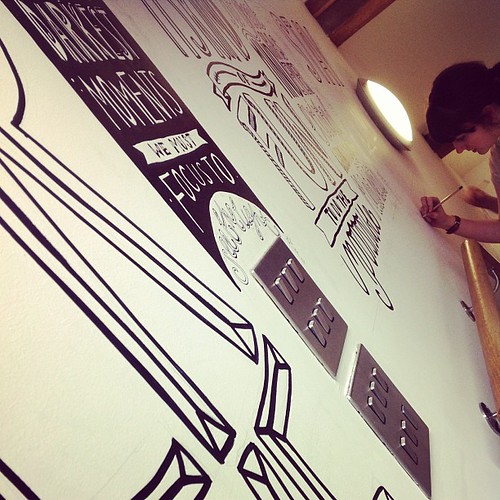Working together can be one of the best, or most frustrating, parts of the process for business owners and creatives.
Designers often have a thought process that is unlike that of the people they are working with to complete a project. While communication is key, there is often a gray area between designers and clients.
So how can you all get along? As a veteran designer, I’ve compiled a few tips for clients (contest holders) on ways better communicate with designers based on my experiences. Hopefully they can help you in working with a designer to complete your next project.
1. Learn Some of the Lingo
It is important to be able to communicate clearly and be on the same page as designers. Knowing some of the design lingo will help you accomplish this.
So where do you start? We’ve got two recent Design Contest blog posts that outline the language of color and typography.
Why is it important? Being able to speak the language will help you avoid confusion and create a dialog with the designer. You don’t want to ok a bevel, if you aren’t really clear as to what a bevel is. And if you don’t know, ask. Generally designers are happy to talk about and explain design.
You don’t need to know it all. Just enough to have a conversation that makes sense.
2. Provide Clear, Direct Instruction
Before you even ask for the first draft from a designer, set and communicate clearly what you want and need in terms of a design project. How will it be used? What’s the message? Are there colors or images that must be used?
Make sure these things are communicated clearly to the designer from the beginning of the project. When running a contest here at Design Contest, you will want to outline those items in the brief. Provide color codes (CMYK, RGB or HEX) for brand specific colors, or links to downloadable image files if necessary.
It is also a good idea to know how you plan to use a design. There are different considerations for something that will be used only online versus online and in printed publication. By stating this up front, you will be more likely to get a design from a designer that best suits your needs.
Finally, if you have an idea of what you want, provide examples. You want to be on the same page as the designer from the start of each project.
3. Be Open to Suggestions
While it is a good idea to be clear about what you do and do not want from a design project, be careful not to “do the designing.†That can be frustrating for any designer and can cause problems.
Remember why you hired the designer in the first place, likely because you liked their work. Allow the creative process time to work and trust the instincts of the designer. And if things are not working, talk about it.
4. Value the Designer’s Time
There’s nothing more important than time when it comes to design projects. The creative process is not a 10-minute job. Respect and value the time it takes for a designer to do the job.
5. Provide Open, Honest Feedback
It may not always be an easy conversation but provide clear and consistent feedback throughout the design process. Make sure to emphasize things that you do any don’t like.
The “It’s OK†response is never OK. The designer won’t be able to learn to adapt to your style if things are OK all the time. Say what you like and why. For example, if you like the color choices for a logo explain what you like about them, such as how they work with your brand image or reflect a product line. Make sure to explain things you dislike just as clearly. You may not like script typefaces because the image is too feminine for your brand or because you think they are hard to read.
Providing clear feedback is one of the surest ways to help get a final product you will be happy with.
6. Know Your Deal-breakers
Know what you can’t live with in terms of design as well.
(Maybe your brand never uses the word “sales†or the color yellow.)
Those “deal-breakers†need to be outlined from the start. And if you don’t know one until you see it? Mention it to the designer right away and explain why that is not an option for the project.
7. Put It in Writing
A contract is your friend. Whether you are working with an in-house designer, freelancer or through a contest here at design contest, a written statement of work, payment and deadlines is important.
When you run a contest here at Design Contest, you get some help on that front. Exchanges of payments are handled through the secure server and rules and guidelines for contest holder-designer relationships and terms of work are clearly stated in the Knowledgebase.
When you work with an in-house designer, the contract is less formal and is often an explanation of work and a give deadline. In-house designers are often more comfortable with brand guidelines and standards and don’t need as much guidance in that area.
Freelance or contract designers should work within a written contract that includes a few basic terms between the parties: Scope of project, final deliverables, deadlines, plan for delays, estimate of work hours or time for project and payment terms.
Do you work with designers on a regular basis? Share your tips for better, more effective communication in the comments.
Creative commons images by University of Fraser Valley, University of Salford and Ross Huggett.






